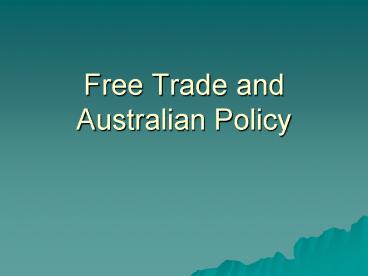Free Trade and Australian Policy PowerPoint PPT Presentation
1 / 16
Title: Free Trade and Australian Policy
1
Free Trade and Australian Policy
2
The idea of free trade self-adjusting markets
.
the unseen hand
An Enquiry into the Nature and Causes of The
Wealth of Nations, 1776
Adam Smith - (1723-1790)
3
Comparative advantage
- If a country is relatively better at making wine
than wool, it should make wine, and to export
wine to pay for imports of wool. This is even
true if that country is an excellent wool
producer, since the country will have more of
both wool and wine than it would have without
trade. A country does not have to be best at
anything to gain from trade.
David Ricardo (1772 - 1823)
4
What actually happened?
- The state remains enormously important in the
development of capitalism
- War and trade are closely linked
- Late developers need state support to catch-up
- Capitalism must be regulated
A ship of Nelsons Navy
5
The nature of pre-capitalist and capitalist crises
- Precapitalist -
- underproduction
- Capitalist
- overproduction
Medieval crisis crop failure
Capitalist crisis unemployment
6
Response to crisis (i)Imperialism
- In the 1870s and 1880s in response to a major
recession in Europe - there takes place a new
scramble for colonies.
Cecil Rhodes astride the whole of Africa
7
Response to crisis (ii)Monopoly
- The laws of supply and demand change when huge
companies can dominate markets
J.P. Morgan
Andrew Carnegie
8
Response to crisis (iii)The formation of blocs
- The Ottawa agreement of 1932
- preference to British empire
- excludes trade from others
- Australia
- loses exports to US and Japan
- pays more for British imports
British delegates at the Ottawa Conference
9
Response to crisis (iv)More state intervention
- The New Deal
- Keynes
- Fascism
- War
John Maynard Keynes
10
The postwar boom
- US dominance
- In 1945 the US had
- 2/3 of worlds gold reserves
- more than half total manufacturing production of
the world - 1/3 of world production of goods of all types.
- The Bretton Woods system meant
- dominance of the US dollar
- a relatively open US economy
- the US was able to fund its deficits through the
dollar system
11
Australias trade policy position in the boom
- The General Agreement on Tariffs and Trade (GATT)
- The position of agriculture in GATT
- Multilateralism versus bilateralism
- trade developing or trade diverting?
- bilateral tend to favour the strong and work
against the weak - how does it fit with GATT WTO? Articles 1 and
24 - Australias position
Black Jack McEwen
12
The end of the postwar boom
- The postwar bargain broken
- US deficits too great
- Nixon takes dollar off the gold standard in 1971
- 1980s US protectionism
- Formation of trading blocs
- By the 1980s free trade rhetoric plus
aggressive restraints of trade - NAFTA - 1994
13
Australia under Labor 1983-96.
- open regionalism of APEC
- Cairns group of agricultural producers
continues multialteral approach
14
Australia under Howard 1996 -
- APEC and Cairns group abandoned
- bilateralism Singapore, Thailand, FTA with the
US
15
Comparison over time
In 1820, Western Europe's per capita income was 3
times that of Africa's.
- By the 1990s it was more than 13 times as high.
16
How the market favours the rich
- For each pound of melon produced by a small El
Salvadoran farmer and retailed in the US for 65
cents - the farmer reaps at best 0.6 per cent of that
revenue - more than 90 per cent of the revenue accrues
outside the country - 75 per cent goes to US shipping, wholesaling,
advertising and retailing.
The case of the El Salvadorean melon

